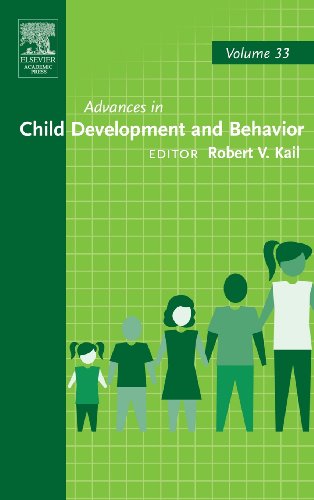

Most ebook files are in PDF format, so you can easily read them using various software such as Foxit Reader or directly on the Google Chrome browser.
Some ebook files are released by publishers in other formats such as .awz, .mobi, .epub, .fb2, etc. You may need to install specific software to read these formats on mobile/PC, such as Calibre.
Please read the tutorial at this link. https://ebooknice.com/page/post?id=faq
We offer FREE conversion to the popular formats you request; however, this may take some time. Therefore, right after payment, please email us, and we will try to provide the service as quickly as possible.
For some exceptional file formats or broken links (if any), please refrain from opening any disputes. Instead, email us first, and we will try to assist within a maximum of 6 hours.
EbookNice Team

Status:
Available4.8
6 reviews
ISBN 10: 0120097338
ISBN 13: 9780120097333
Author: Robert V Kail
Volume 36 of the Advances in Child Development and Behavior series includes ten chapters that highlight some of the most recent research in developmental and educational psychology.
A wide array of topics are discussed in detail, including King Solomon's Take on Word Learning, Orthographic Learning, Attachment and Affect Regulation, Function, Family Dynamics, Rational Thought, Childhood Aggression, Social Cognitive Neuroscience of Infancy, Children's Thinking, and Remote Transfer in Children, and much more. Each chapter provides in depth discussions of various developmental psychology specializations. This volume serves as an invaluable resource for psychology researchers and advanced psychology students.
*Goes in depth to address 10 different developmental and educational psychology topics
*A necessary resource for both psychology researchers and students
Chapter 1. King Solomon’s Take on Word Learning: An Integrative Account from the Radical Middle
I. The Word Learning Problem
II. The Emergentist Coalition Model (ECM)
III. Validating the Model
IV. Implications of the ECM for Language Disorder: The Case of Autism
V. Implications of a ‘‘Radical Middle’’ Approach: Three Take-Home Messages
References
Chapter 2. Orthographic learning, phonological recoding, and self-teaching
I. Introduction
II. The Self-Teaching Theory of Orthographic Learning
III. Empirical Findings
IV. Summary, Conclusions, and the Way Ahead
References
Chapter 3. Developmental perspectives on links between attachment and affect regulation over the lif
I. Review of Attachment Theory
II. Affect Regulation
III. Attachment and Affect Regulation During Adolescence
IV. Implications and Future Directions
References
Chapter 4. Function revisited: how infants construe functional features in their representation of o
I. Introduction
II. The Construct of Object Function
III. A New Conception of Function
IV. Our Research on Infants’ Attention to and Representation of Function
V. Conclusions
References
Chapter 5. Transactional family dynamics: A new framework for conceptualizing family influence proce
I. Introduction
II. Setting the Stage
III. Transactional Family Dynamics: An Emerging Theme
IV. Mapping Empirical Work onto a Transactional Family Dynamics Framework
Discussion
References
Chapter 6. The development of rational thought: a taxonomy of heuristics and biases
I. Introduction
II. Experimentally Tractable Definitions of Rational Thought
III. Dual-Process Models of Cognition
IV. A Preliminary Taxonomy of Rational Thinking Errors
V. Classifying Heuristics and Biases
VI. Exemplar Developmental Studies in the Different Categories of the Taxonomy
VII. Conclusion: Specificity and Generality in the Development of Rational Thought
References
Chapter 7. Lessons learned: recent advances in understanding and preventing childhood aggression
I. Introduction
II. The Adaptive Functions of Aggression
III. Aggression and the Ecology of Development
IV. Risk, Causality, and Prevention
V. Translating Research to Practice: Building an Evidence Base
VI. Conclusion
References
Chapter 8. The social cognitive neuroscience of infancy: Illuminating the early development of socia
I. Introduction
II. Face Processing
III. Eye Gaze Processing
IV. Perception of Emotions
V. Interactions Between Face Identity, Eye Gaze, and Emotion
VI. Conclusions
References
Chapter 9. Children’s thinking is not just about what is in the head: Understanding the organism a
I. Introduction
II. The General Theoretical Framework
III. The Development of Spatial Categorization
IV. Explaining the Emergence of Spatial Categorization Skills
V. Limits and Conclusions
References
Chapter 10. Remote transfer of scientific-reasoning and problem-solving strategies in children
I. Introduction: Theoretical, Empirical, and Practical Importance of Research in Remote Transfer
II. Paradox, Taxonomy, and Paradigms
III. Evidence of Remote Transfer I: Experimental Approach
IV. Evidence of Remote Transfer II: Naturalistic, Cross-Cultural Approach
V. Processes Involved in Remote Transfer
VI. Developmental Differences
VII. Educational Implications
VIII. Conclusions and Future Directions
advances in child development and behavior
child development and education 6th edition pdf
the developing child textbook pdf chapter 3
child development an active learning approach 3rd edition pdf free
child development an active learning approach 3rd edition ebook
the developing child textbook pdf chapter 4
Tags: Robert V Kail, Advances, Development